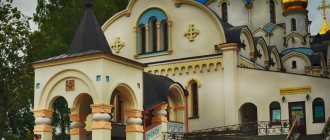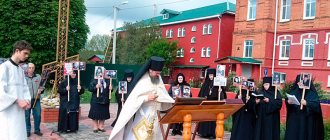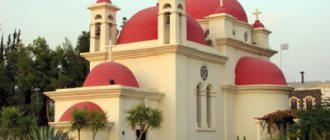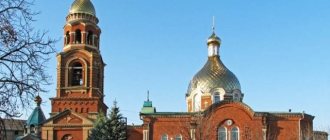The Holy Synod of the Russian Orthodox Church (ROC) on Tuesday, August 25, dismissed Metropolitan Pavel of Minsk and Zaslavsky, the head of the Belarusian Orthodox Church (BOC), from the post of Patriarchal Exarch of All Belarus. The Synod, having satisfied the corresponding request of Metropolitan Paul, transferred him to a new place of service - to the Kuban Metropolis. Bishop Veniamin of Borisov and Maryingor has been appointed the new leader of the BOC.
In the Belarusian segment of social networks, these personnel changes caused a mixed reaction. Some were happy that instead of a Russian citizen, the BOC was headed by a Belarusian citizen, others noted that the change of hierarchs occurred after Metropolitan Pavel apologized for hastily congratulating Alexander Lukashenko on his victory in the presidential election and criticized the repression of protest participants in the country.
The Orthodox Church responded to repressions in Belarus
Meanwhile, the Synod of the Russian Orthodox Church published a resolution on the evening of August 25, in which it declared support for the efforts of Metropolitan Pavel aimed at restoring peace and public tranquility in Belarus. The Russian Orthodox Church called “it is important for the authorities of the Republic of Belarus to thoroughly investigate all cases of violence against both citizens and law enforcement officers, and punish those responsible for violating the law.”
Protest in Minsk, August 23
The newly appointed head of the BOC, Bishop Veniamin, made his first address on August 26, in which he called on the Orthodox to fast for three days and emphasized: “The latest sorrowful events in our Fatherland occurred because our hearts were inclined in the bad direction. Because the light of Christ could not shine in this dark time, when the sin of iniquity manifested itself.”
What's happening at the BOC now?
As the chairman of the information department of the BOC, Archpriest Sergei Lepin, explained in an interview with DW, “technically, Bishop Veniamin is already a patriarchal exarch - as soon as the synod decides on this. He gradually takes over and begins to fulfill his duties.” According to Lepin, Bishop Veniamin will soon be elevated to the rank of metropolitan.
Metropolitan Pavel (pictured in the center)
Metropolitan Pavel has not yet returned from a business trip from Moscow. “We know that according to plans, Bishop Pavel is to come to Zhirovichi on August 28 for the Day of the Dormition of Our Blessed Lady Theotokos - to the Assumption Zhirovichi Monastery, where he will serve a festive service, say goodbye to the brethren and seminarians, and the teaching staff. And on the 30th there will be a service in the Cathedral of the city of Minsk (Holy Spirit Cathedral - Ed.). Both clergy and laity will also be invited. Perhaps this will be the Bishop’s final service in our country,” Lepin added.
Rudkovsky: Vladyka Veniamin is still a mystery
Director of the Belarusian Institute of Strategic Studies (BISS) registered in Vilnius, Petr Rudkovsky (his area of scientific interest is the political potential of Belarusian churches) noted in an interview with DW that he is inclined to agree with the official version of personnel changes in the BOC. According to him, Metropolitan Pavel himself wanted to change his place of service: “He got confused in this difficult situation - both political and, possibly, internal to the church. Therefore, I think that this was a consensus decision made by Pavel and the leadership of the Russian Orthodox Church.”
Rudkovsky drew attention to the fact that “the release from office and appointment to another of Metropolitan Pavel was accompanied by clear cordial support for his activities and his position regarding the latest events in Belarus - the Synod of the Russian Orthodox Church expressed solidarity with the position of Metropolitan Pavel.”
The expert believes that the figure of the new head of the BOC is still a mystery: “On the one hand, Bishop Benjamin is an educated, bright man, has organizational experience in educational activities, the creation of a theological school (in 2014, the Synod of the BOC appointed him chairman of the department of religious education and catechesis. - Ed.). On the other hand, Benjamin has an orderly attitude in his perception of socio-political processes.”
Rudkovsky believes that it is too early to predict how loyal the new head of the BOC will be to the Belarusian authorities. “Perhaps he will be more inclined to support the position of the authorities. But I am convinced that this will not be at any cost and will have certain limits. Still, there is no doubt that this is a deeply religious person. Everyone unanimously affirms that he is a pious man,” says the BISS director. “If in Belarus, God forbid, such terror as August 9-11 is repeated, then I don’t think that Bishop Veniamin will praise the authorities,” Rudkovsky said.
Who is Bishop Benjamin
In turn, Nikolai Lis, who collaborated with Bishop Veniamin during his work in the Synodal Department of Religious Education and Catechesis of the BOC, spoke very warmly about him as a person in an interview with DW. “Very kind, very gentle person in dealing with people. If he makes a commitment, he always strives to fulfill it,” Lis shared.
Bishop Veniamin (in the world - Vitaly Tupeko) was born on September 16, 1968 in the city of Luninets, Brest region. By first education he is a radiophysicist engineer (graduated from the Belarusian State University in 1992), by his second he is a candidate of theology (Minsk Theological Academy, 1999). In 1994 he was tonsured a monk with the name Benjamin. In 2010, he was appointed Bishop of Borisov, vicar of the Minsk diocese.
See also:
Protests in Belarus after the presidential elections: how it happened
The beginning of the protests
After the polling stations closed on August 9, thousands of Belarusians took to the streets of Minsk and other cities to protest. At that time, the results of the official exit poll were announced, according to which Alexander Lukashenko received about 80% of the votes, his main rival Svetlana Tikhanovskaya - about 7%.
Protests in Belarus after the presidential elections: how it happened
Spontaneous actions
Mass protests began at 21:00 local time. In Minsk, the main buildings and squares were cordoned off in advance by security forces and blocked with military equipment. Central metro stations were closed. Protests took place spontaneously and in different parts of the city.
Protests in Belarus after the presidential elections: how it happened
Protester gathering points
The main place of protest in Minsk was Pobediteley Avenue, with the “Minsk - Hero City” stela located on it, as well as the central Nemiga street, which intersects with the avenue. According to various estimates, up to 5,000 residents of the capital gathered there. In other cities, people protested in central squares.
Protests in Belarus after the presidential elections: how it happened
Structure and administration of the diocese
The Orthodox Church of Belarus is administratively independent and is under the control of the Holy Synod. The board is composed of representatives of the highest spiritual ranks - the ruling bishops of the exarchate and the Patriarch himself. The BOC and its legal status are regulated by the Charter of the Russian Orthodox Church (Chapter 9) and the internal statute of the church.
The Synod operates within the framework of the competence granted to it by the Holy Assembly of the Russian Orthodox Church and is fully accountable to the Patriarch of Moscow and All Rus' Kirill. But even despite this, the Belarusian Exarchate has enough powers. Thus, the highest church collegial body has the right, by its own decision:
- select and submit for consideration to the highest church body (the Holy Synod) candidates for vicar and acting hierarchs of the BOC, bishops as temporary participants in the Holy Government Body of the Russian Orthodox Church;
- approve the positions of leaders (abbots) of monasteries;
- resolve regional church and religious disputes;
- supervise the activities of Orthodox theological seminaries and schools;
- coordinate the social mission and train the clergy reserve.
The structure of the exarchate of Belarus is extensive and includes a branched system. As for the main districts of the BOC, there are six of them. Each region includes parishes, deaneries, metochions, monasteries, diocesan institutions, missions and other canonical parts of the Russian Orthodox Church.
Brest region
- Brest diocese
The beginning of official activities and establishment is 1990. Includes regional and district churches of the Brest district. The leading cathedrals are the temples of Simeon the Stylite and Alexander Nevsky.
Temple of Simeon the Stylite:
Temple of Alexander Nevsky:
- Pinsk diocese
Represents the Orthodox Church of the eastern part of Belarus, with a length of 19 thousand km². The capital of the district is the city of Pinsk. The main altars are the St. Barbara's Cathedral and the Church of the Exaltation of the Holy Cross. One of the oldest dioceses, founded in the 14th century.
St. Barbara's Cathedral:
Church of the Exaltation of the Holy Cross:
Vitebsk region
- Vitebsk diocese
The period of creation of the modern department dates back to 1992, but the first thrones were erected during the times of Kievan Rus. Today the region includes 11 large administrative districts with the diocesan center in the city of Vitebsk. Cathedral - Holy Protection Church:
- Polotsk diocese
Cathedral Orthodox churches - the Church of the Epiphany in Polotsk and the Cathedral of the Nativity of the Virgin Mary in Glubokoe. The church region has up to 100 parishes.
Church of the Epiphany in Polotsk:
Cathedral of the Nativity of the Virgin Mary in Glubokoe:
Gomel region
- Gomel diocese
Unites Belarusian deaneries and monasteries of the eastern Gomel region. About 150 parishes are supported.
- Turov diocese
It has an ancient history and wide geography. Located in the western lands of the Gomel region. There are 58 parishes in the district. The year of foundation is considered to be 1005. The capital of the diocese is the city of Mozyr. The church of the Archangel Michael and Saints Cyril and Lawrence took on the cathedral role:
The Grodno region
- Grodno diocese
Western part of the Grodno district. There are up to 97 Orthodox districts. The main churches are the Intercession and St. Nicholas Cathedrals. It was originally established from the Lithuanian and Vilna dioceses, but since 1900 it has been listed as Brest and Grodno.
Intercession Cathedral:
St. Nicholas Cathedral:
- Novogrudok diocese
Founded in the 15th century on the territory of the Dyatlovo, Korelichi, Novogrudok and Slonim districts of the Grodno district. Has up to 100 parishes. The cathedral Orthodox churches are St. Nicholas and Spaso-Preobrazhenskaya.
- Lida diocese
Consists of the districts Ivyevsky, Lida, Oshmyany, Ostrovetsky and Smorgonsky. The diocese was formed by separation from Novogrudok in 2014 by a resolution of the Holy College of the Russian Orthodox Church.
Minsk Region
- Minsk diocese
Main district of the Belarusian Exarchate. The date of establishment was accepted as 1793. Since 2014, the territory of the Orthodox diocese is limited and includes only the districts of Minsk and the Minsk region.
- Borisov diocese
It was allocated by the Holy Synod of the Russian Orthodox Church from part of the Minsk district into independent regions.
- Molodechno diocese
It is located within the Minsk district (metropolis). The maximum boundaries of the district extend to Vileika, Dzerzhinsky, Volozhinsky, Myadelsky, Uzdensky, Molodenchesky and Stolbtsovsky districts.
- Slutsk diocese
The region was finally approved as an administrative unit independent of the Minsk metropolis in 2014 by the Synodal Decree of the Russian Orthodox Church.
Mogilev region
- Mogilev diocese
The district from the Polotsk metropolis is allocated. Founded in the 17th century. Since 2004 it has been an independent diocese.
- Bobruisk diocese
Covers Glussky, Klichevsky, Bykhovsky, Kirovsky, Bobruisk and Osipovichi districts. Approved by the Patriarchal College in 2004.
Thirst for change
Many protesters were holding historical white-red-white flags. Slogans were heard: “Go away,” “Freedom,” “The police are with the people,” and Tsoi’s song “Change.” Passing cars honked their horns at the protesters, expressing support. Flashlights on mobile phones have turned into a sea of lights.
Protests in Belarus after the presidential elections: how it happened
Primates
- Filaret (Vakhromeev) (October 16, 1989 - December 25, 2013)
- Pavel (Ponomarev) (December 25, 2013 - August 25, 2020)
- Veniamin (Tupeco) (from August 25, 2020)
Historical titles of the primate
- Metropolitan of Minsk and Grodno, Patriarchal Exarch of All Belarus (October 16, 1989 - February 18, 1992)
- Metropolitan of Minsk and Slutsk, Patriarchal Exarch of All Belarus (February 18, 1992 - October 23, 2014)
- Metropolitan of Minsk and Zaslavsky, Patriarchal Exarch of All Belarus (since October 23, 2014)
Calls for peace
Night protests took place not only in the capital, but also in all regional centers - Brest, Grodno, Vitebsk, Mogilev, Gomel, as well as small towns, in particular, Novopolotsk, Soligorsk, Baranovichi, Lida, Zhodino, Kobrin, Volkovysk, Slonim, Polotsk, Bobruisk, Molodechno. People called on the riot police to lower their shields and come over to their side.
Protests in Belarus after the presidential elections: how it happened
Start of acceleration and use of special equipment
After 22:00, the “cleansing” began in Minsk. Lines of riot police with shields moved towards each other, pushing protesters out of the streets and squares. There were some clashes with riot police. During the dispersal of protests, security forces used stun grenades, firecrackers, rubber bullets, and water cannons against protest participants. There were also reports in the media about the use of tear gas.
Protests in Belarus after the presidential elections: how it happened
Road barricades and casualties
On Pobediteley Avenue, protesters built barricades from garbage containers to block the road. According to the Ministry of Internal Affairs, during the clashes over the past 24 hours, more than 50 citizens and 39 security officials were injured. The human rights activist also reported one death due to a collision with special equipment. The Ministry of Internal Affairs denied this information. One video on social media shows a paddy wagon running over a protester in Minsk.
Protests in Belarus after the presidential elections: how it happened
Commissions, departments, institutions
- Department of External Relations
- Bible Commission
- Legal department
- Department for Cooperation with the Armed Forces
- Department for interaction with the Committee for the Execution of Punishments under the Ministry of Internal Affairs of the Republic of Belarus
- Department of Church Art, Architecture and Restoration
- Responsible for relations with television and radio campaigns
- Economy
- Press Secretary of the Patriarchal Exarch
- Accounting
- Publishing House of the Belarusian Exarchate
- Library
- Editorial office of the newspaper "Tsarkounae Slova"
- Information and Consulting Center named after. Venerable Joseph of Volotsky
- Book warehouse
- Candle warehouse
Riot charge
By 1 a.m. Belarusian time, the police in Minsk took control of the situation. According to the Ministry of Internal Affairs of Belarus, as of August 10, a total of about 3,000 people were detained, about 1,000 in the capital and more than 2,000 in other regions of the republic. They are accused of riots and violence against the police.
Protests in Belarus after the presidential elections: how it happened
Educational institutions, stauropegia
The Belarusian Exarchate has extensive capabilities for training a new generation of clergy. For this purpose, a special department of catechesis and religious education has been created, which is in charge of specialized training in church hymn, reading and icon painting for dioceses and deaneries.
The BOC is also able to provide decent secondary religious education. Now there are over a hundred socialist church institutions and about 654 Sunday schools. The most famous educational institutions are:
- Minsk Theological Academy;
- Vitebsk and Minsk theological seminaries;
- Solomino, Minsk and Vitebsk religious schools.
Departments offered by educational institutions: theological and pedagogical; psalm regents; missionary; preparatory for admission to theological universities. Training can also be carried out via correspondence.
Belarusian Orthodox stauropegians - Holy Dormition Zhirovichi Monastery, Holy Nativity of the Virgin Mary Convent (city of Grodno), Holy Vvedensky Monastery (village of Bogushi), Spaso-Efrosinievsky Convent (city of Polotsk).
The degree of violence has increased
On the night of August 11, the protests continued, becoming more violent. Military equipment that had not previously been used to disperse demonstrations in Belarus appeared in Minsk. Photos and videos from the scene show protesters using Molotov cocktails. And the security forces throw stun grenades at the moving car, after which the driver presses on the gas and crashes into a group of riot police.
Protests in Belarus after the presidential elections: how it happened
Troubles are expelled from the Belarusian Exarchate of the Russian Orthodox Church, and Hasidim are expelled from Ukraine
Photo from the official website of the BOC / church.by
The Synod of the Moscow Patriarchate on Tuesday succeeded in something that the people still cannot: change the leader in Belarus. True, only church. Metropolitan Pavel (Ponomarenko) was transferred to the Kuban See, and Bishop Veniamin (Tupeco) took his place as Patriarchal Exarch in Minsk. It has been suggested that Paul fluctuated too much in response to the changing political weather. He even called on Lukashenko to restrain violence against protesters. At the same time, he was an outsider; he was never given citizenship.
In the “squiggle” with Bishop Veniamin, one can see the same calculation that was once made during the election of Kyiv Metropolitan Onuphry (Berezovsky): a native of the country, but at the same time firmly adhering to church unity with Moscow. Veniamin was born in the Brest region; by analogy with Ukrainian concepts, he can be called a “Westerner.” He outlined his conservative position when he explained the meaning of the prayer service held in the country's Orthodox churches on Sunday, August 30. “We are all filled with the hope of quickly calming the unrest among our people, establishing blessed peace and tranquility,” said the new exarch. And Patriarch Kirill himself on Sunday congratulated Alexander Lukashenko on his birthday and promised that “the development of interaction between the church and government agencies and all the healthy forces of society will contribute to the spiritual, moral and patriotic education of the inhabitants of Belarus.”
The head of the Russian Orthodox Church (few doubt that the Synod merely carried out the decisions of its chairman) made many more reshuffles of the ruling bishops. The metropolitans' travel routes are so intricate that it is quite difficult to find any pattern in them. There have been changes in the educational and economic institutions of the Russian Orthodox Church. From all this personnel leapfrog, we can draw a conclusion-assumption: the patriarch twists and turns, wants to confuse, not to allow the rulers to stay in their places, to acquire connections and habits. In other words, man-made turbulence is created - probably seen as an effective management technology.
Among the decisions of the Synod, the removal of Archpriest Dmitry Smirnov from the post of chairman of the Patriarchal Commission for Family Affairs also attracted attention. He was, perhaps, the last of that generation of clergy who allowed themselves scandalous statements and at the same time held official positions in important church institutions. Dmitry Smirnov glorified nuclear Orthodoxy, advised donating the last kidney to the church, and said many other things that the old school of Orthodox missionary considered necessary to “awaken” public attention, a reason to call people to dialogue. True, the dialogue mainly took the form of swearing.
The Russian Orthodox Church is becoming an increasingly cautious and closed organization. The Synod warned clergy and monastics against disclosing confidential information about the Russian Orthodox Church and established penalties for those who do not follow this rule. In particular, for a cleric, such disclosure will entail a ban in ministry for up to one year (up to three years if the same act is committed again). Only the patriarch or diocesan bishop can give permission to disclose confidential information about the church.
While the Russian Orthodox Church is moving closer to the Belarusian authorities, Catholics in the country are increasingly drifting towards the opposition and quarreling with Lukashenko. On Wednesday evening, law enforcement officers dispersed a protest rally in Minsk and blocked dozens of protesting citizens in the Red Church. The leader of the country's Catholics, Archbishop Tadeusz Kondrusiewicz, and two other bishops protested. On Thursday, Belarusian women held an action at the Red Church in the now traditional “chain of solidarity” format.
The Belarusian government is fighting protests, and Ukrainian politicians and officials are fighting the “threat” from outside. On Friday, the Ukrainian border service reported that it had not allowed dozens of Hasidic pilgrims into the country who were breaking into the city of Uman to worship the ashes of Rabbi Nachman. Foreigners are suspected of carrying coronavirus. The demand to block the way into the country for the Jews comes from the very bottom. On the night of Friday, there was a clash between the residents of Uman and those Hasidim who nevertheless entered the country: people did not allow the newcomers into the city, accusing them of intending to infect the locals with COVID-19. Ukrainian President Vladimir Zelensky and Israeli Prime Minister Benjamin Netanyahu previously called on believers to abandon the pilgrimage this year.
First victims
On August 10, an explosion occurred on Pritytskogo Street in Minsk, which killed one of the protesters. According to the Ministry of Internal Affairs of Belarus, an explosive device detonated in the man’s hands, which he wanted to throw at the police officers. At the same time, the authors of the Telegram channel “Belarus of the Brain” believe that the man could have died after security forces threw a flash-noise grenade at his feet.
Protests in Belarus after the presidential elections: how it happened
History of formation
The Belarusian Exarchate was founded in 1989 as a result of the synodal decision adopted at the local Council of the Russian Orthodox Church on the creation of an independent vicarious district of Belarus in church unity and subordination to the Russian Orthodox Church. The same conciliar resolution finally fixed the status of the three previously approved dioceses of Mogilev, Pinsk and Polotsk.
Since October of the same year, the Holy Collegiate Body of the Russian Orthodox Church ratified a new patriarchal rank for the head of the Belarusian Church, elevating the bishop to the rank of Metropolitan of Minsk and Zaslavsky. Today, the Exarch of Belarus is the Patriarchal Bishop and vicar of His Grace Kirill. The entire local episcopate and metropolitans are subordinate to the Patriarch of the BOC.
The autonomy of the Belarusian Exarchate is officially recognized by the churches of Ecumenical Orthodoxy, which indicates that the BOC has an independent right to carry out administrative and territorial regulation in accordance with Orthodox canonical rules. The administrative center of the church district is the Minsk region, including the capital of the Republic of Minsk.
Under the leadership of the Minsk diocese, the Holy Bishop and the Synod of the BOC there are the main church departments and structural units - the Control and Canonical Council, the Secretariat of the Administration of the Orthodox Exarchate, the department of the patriarchal press service and office work, the legal and financial-economic service and other church-administrative elements.
The main metropolitan department is located within the walls of the Holy Spiritual Cathedral in the city of Minsk, and the second most important department is in the Church of the Transfiguration of the Lord in the city of Zaslavl. The Minsk diocese was finally reorganized in February (magazine No. 13,15) 1992 by the synodal decision of the Belarusian Orthodox Church. According to this document, the territory of the exarchate was clearly limited to the Minsk region.
By the time the exarchate was formed, the BOC included 4 diocesan lands - Minsk, Polotsk, Mogilev and Pinsk. Later, 6 more Orthodox districts were revived - Brest, Gomel, Novogrudok, Grodno, Turov and Vitebsk. And since 2007, a new district has been created - Bobruisk. Today the Belarusian Exarchate includes 15 separate dioceses, 1612 parishes, 35 monasteries, specialized educational institutions and other organizational elements of the BOC.
The importance of the BOC for modern society in conditions of global demoralization and moral decline is difficult to overestimate. It is no coincidence that in 2008, during his stay in the Minsk Holy Spirit Cathedral, the President of Belarus called the BOC the main ideologist of the country.
Daytime peaceful protests
At the Komarovsky market in Minsk on the afternoon of August 12, 250 girls with roses in their hands lined up in a chain as a sign of solidarity with those who suffered from violence these days. Soon the police appeared and through a loudspeaker demanded to disperse, warning about “legal responsibility.” The girls shouted “Shame!”, laid flowers on the ground and dispersed. Similar actions took place in other cities of the country.
Protests in Belarus after the presidential elections: how it happened
Alexievich called on Lukashenko to resign
On the evening of August 12, protests again took place in different cities of the country, this time ending without violent clashes with security forces. According to the Ministry of Internal Affairs, another 700 people were detained during the day. In Gomel, a 25-year-old guy died after being detained. Several TV presenters wrote letters of resignation from state TV, and Nobel laureate Svetlana Alexievich called on Lukashenko to resign.
Protests in Belarus after the presidential elections: how it happened
Detainees began to be released
The night of August 13-14 passed for the first time without violence against protesters. From the Center for Isolation of Offenses of the Central Internal Affairs Directorate of the Minsk City Executive Committee, known in Minsk as “Akrestina,” they began to release those detained at protest rallies. Many of them talked about torture, overcrowded cells, and complained of hunger and thirst. Someone needed medical attention.
Protests in Belarus after the presidential elections: how it happened
How the replacement of the head of the Belarusian church is related to the protests
On September 6, Patriarch Kirill of Moscow and All Rus' will elevate Bishop Benjamin of Minsk and Zaslavl to the rank of metropolitan. As the press service of the Moscow Patriarchate of the Russian Orthodox Church (ROC) notes, the rite of elevating a bishop to the rank of metropolitan will be performed during the liturgy in the Cathedral of Christ the Savior in Moscow.
Bishop Benjamin became Patriarchal Exarch of all Belarus at the end of August, replacing Metropolitan Pavel in this post. The elevation of the new exarch to the rank of metropolitan can be called the final stage of the reshuffle in the leadership of the Belarusian Orthodox Church (BOC), which is subordinate to the Moscow Patriarchate.
The decision of the Synod of the Russian Orthodox Church on Metropolitan Paul occurred against the backdrop of a political crisis in Belarus. Since August 9, mass protests have been taking place in the republic against the re-election of Alexander Lukashenko as president, which are partly supported by representatives of various religious organizations.
Pavel expressed a somewhat ambiguous position on the situation in the republic. So, initially he supported the head of state and congratulated him on his victory in the elections, following Patriarch Kirill. However, then the Belarusian Metropolitan withdrew his congratulations due to the particular cruelty of the security forces during the detention of protest participants.
Subsequently, Pavel officially appealed to Lukashenko to stop the violence in the country, began visiting victims in hospitals and participating in religious processions organized in support of the peaceful removal of the president from power.
As a result, a rather ambiguous situation developed around the BOC, which opened the way for different interpretations of the decision of the ROC Synod to transfer Paul from Belarus to the Kuban Metropolis. Independent media actively promoted the version that the metropolitan was removed at the request of Lukashenko, and Veniamin, who replaced him, would adhere to a more pro-government course.
Church protest
If we consider the departure of Metropolitan Paul in connection with Minsk, then there is still no clear connection here. Yes, Lukashenko quite openly said that he was surprised by the position of some confessions in Belarus, although he did not make direct attacks towards the BOC.
“My dear clergy, settle down and mind your own business. People should come to churches to pray! Churches and churches are not for politics. People should come there with their souls, as it has always been,” the President of Belarus pointed out.
Representatives of the church should not follow the lead of the renegades, Lukashenko said, most likely referring to the protesters, since the demonstrations in Minsk themselves were initially viewed as provocations of “Western puppet masters.”
“You will be ashamed and disgraceful for the position you, some of you, are taking now. And the state will not look at this with indifference,” the Belarusian leader emphasized.
With his statement, Lukashenko partly hinted that church representatives would have to answer for their position. The head of state admitted four years ago that he did not understand the thesis about the separation of church and state - demanding that the BOC be aware that it must adapt to working in a sovereign and independent state.
However, the irritation of the Belarusian leader is unlikely to have played a special role in the transfer of Metropolitan Pavel, since his position on the Belarusian crisis was supported by the synod of the Russian Orthodox Church.
At a meeting in late August, church representatives called on the Belarusian authorities to investigate cases of violence at protests against both citizens and law enforcement officers.
By the way, the synod of the Russian Orthodox Church also approved the appeal of the BOC to the people of the republic to end the confrontation, which was issued under Metropolitan Paul, which again made its reaction to the protests somewhat ambiguous.
If we talk about the authorities’ fears about the “interference” of the church in the political crisis, then it is unlikely that the BOC will be able to become a consolidating factor in the protests. For the most part, the demonstrations are not tied even to Lukashenko’s opponents, although many activists call the opposition candidate Svetlana Tikhanovskaya the winner of the elections.
According to estimates by the Belarusian Information and Analytical Center, about 65% of the population of the republic are believers. By denomination, Orthodoxy predominates; according to a 2015 State Department survey, 68% of Belarusians consider themselves to be members of the BOC, 14% profess Catholicism and 3% belong to other religious groups. However, according to Gallup ratings, Belarus is among the top 15 least religious countries in the world - only 34% of Belarusians admit that faith plays an important role in their lives.
Autocephalous trend
If we exclude the option of Lukashenko’s request, then the change of exarch in such a situation can be explained by the dissatisfaction of the Russian Orthodox Church with Metropolitan Pavel, although no conflict can be traced at the official level. There are certain questions for the ex-head of the BOC, and, mainly, they are related to his soft attitude towards the unfolding discussion about the autocephaly of the Belarusian Church. Once the exarch himself even called for independence of the BOC, but quickly renounced this position.
Why the Russian Orthodox Church decided to replace him precisely against the backdrop of protests is quite obvious - the topic of autocephaly of the Belarusian Church again became relevant, which required the appointment of the head of the BOC with a tougher position.
The issue of independence of the Belarusian church from the Moscow Patriarchate, in fact, has been discussed since the beginning of protests in various religious media; this trend has acquired particular value in Ukraine. Last year, the Orthodox Church of Ukraine (OCU) received a tomos of autocephaly from the Patriarchate of Constantinople, which the Russian Orthodox Church refused to recognize, since the Ukrainian Church was initially subordinate to the Moscow Patriarchate.
This event in itself launched a wave of discussions about the independence of the church structures of the Russian Orthodox Church in Moldova and Belarus, and the Belarusian political crisis only strengthened this trend.
During the conflict with the Russian Orthodox Church, the Ecumenical Patriarchate canceled the decision to transfer the Kyiv Metropolis, which included the territory of Belarus in the 17th century, under the control of the Moscow Patriarch.
Many priests and observers in Ukraine began to use this to confirm the right of Belarusians to demand autocephaly - because de jure the Belarusian church came under the jurisdiction of the Patriarchate of Constantinople, and not the Moscow one.
As the priest of the OCU Georgy Kovalenko said, an analogue of the Ukrainian independent church already exists in Belarus, which is confirmed by the protests in the republic. “The Orthodox Church of Belarus is already a reality, although not yet realized and organized,” the clergyman pointed out.
At the same time, the Belarusian Autocephalous Orthodox Church (BAOC), which has been in exile since 1944 and based in New York, also joined this track. The head of the BAOC, Archbishop Svyatoslav, openly opposed Lukashenko, calling for a change of power in the country. According to him, the autocephalous church operates underground in Belarus and actively supports the protests - priests of the unrecognized structure even took part in a pan-Christian prayer in the Minsk Catholic Church, where representatives of the BOC were also present.
Again, the involvement of the priests of the Belarusian Orthodox Church in the protests through religious processions, prayers and even rallies was an alarming call. That is, some representatives of the BOC clearly do not agree with the recognition of Lukashenko as president. It is possible that such discontent may develop into a desire to leave the church or demand its independence.
While representatives of the Belarusian Orthodox Church itself are not talking about such plans, even opposition-minded clergy did not mention the issue of autocephaly against the backdrop of the political crisis in the republic.
However, it cannot be denied that the very fact of discussing such a topic worries the Russian Orthodox Church, and the new exarch will have the task of resolving this problem. In general, only one thing can be stated: the transition of the Belarusian church to independence according to the Ukrainian model is an extremely negative scenario for the Russian Orthodox Church, and, most likely, the Moscow Patriarchate will do everything possible to avoid it.






